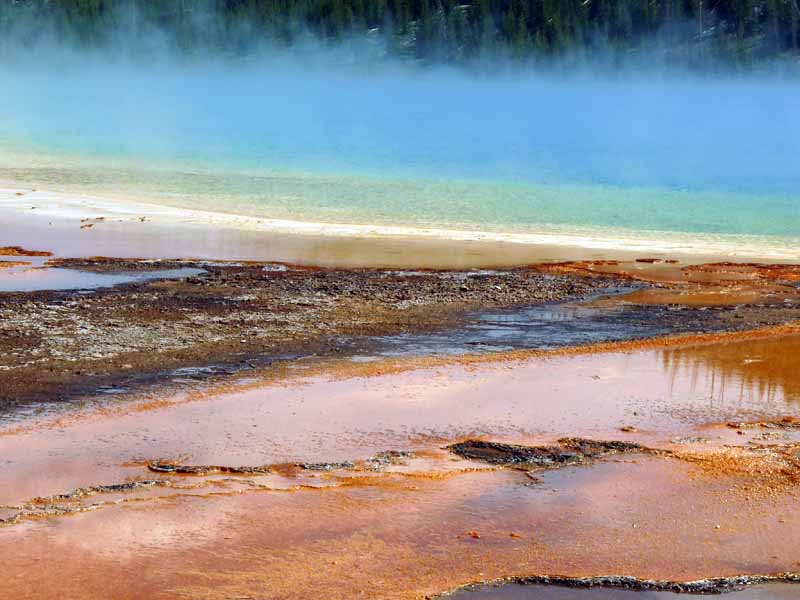President’s blog 2009–2012
By Phil Greaves
March 2012
Sadly (for me at least) this will be my final ‘President’s Blog’ – today (13 March) I hand over the badge of office to our new President Charles Hussey at the Annual General Meeting. I wish him well in this role, and hope he enjoys it as much as I have.
It has been a great privilege to serve the Club in this capacity, and it has been the fastest 3 years of my life! I didn’t get around as many meetings as I had hoped to – apologies to those that I missed – and I hadn’t anticipated the Owen Bequest, which has caused a significant rethink of how we use the funds now available to the Club for the benefit of all, public and member alike. What has pleased me has been the slow but steady increase in membership. What continues to amaze me (after 35 years in this hobby) is how friendly, sharing and genuine amateur microscopists are – you couldn’t wish for a better group of people.
2012 has started well for me; we had our annual trip out to Australia to meet up with the family and now the grand-daughters are a little older I took (and left) a stereomicroscope for them. Seeing their excitement at pond-life, and the fun of chasing beasties around with a pipette was an absolute pleasure – and one that so many children miss.
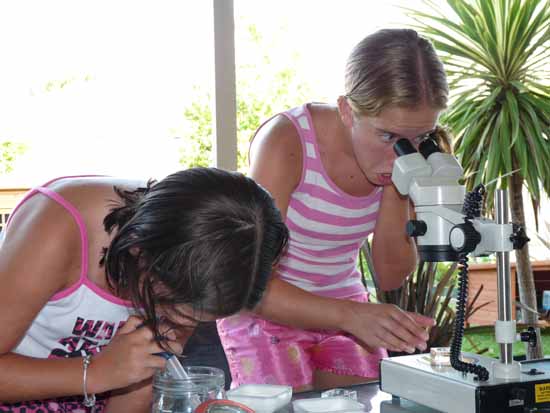 Phil’s grand-daughters with a stereomicroscope
Phil’s grand-daughters with a stereomicroscope
This is the first time we have been in high summer and we took the opportunity to revisit Lake Preston, about 1 hour south of Perth. This is a saline lake which is one of the few places where stromatolites (technically thrombolites in this lake) can be seen. The lower lake level in summer allowed a much better view of these structures – they continue to fascinate me.
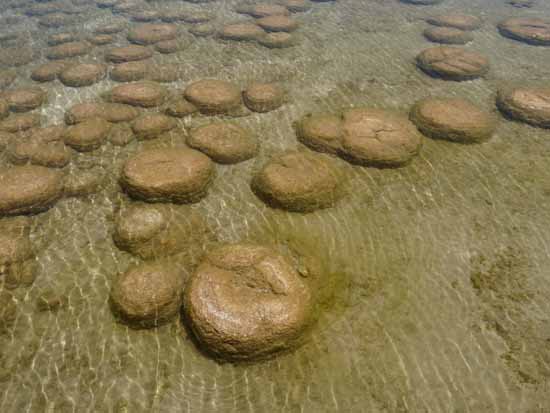 Thrombolites in Lake Preston
Thrombolites in Lake Preston
Back home and I have finally made it back onto the horse after the unplanned landing and minor injury last September. It is good to see the countryside from a higher perspective again, but both horse and I are unfit and I hope the longer evenings give me some chance to get out more.
I also hope to spend more of the evenings doing some photomicrography again. Much of my time recently has been spent with the Members’ Auction and more recently preparing for the Reading Meeting. Microscopists seem to have a never-ending desire for accessories and slides for which I am most grateful; with the auction and Reading combined I have been able to return nearly £10,000 to the relatives of some of the Club members we lost last year.
Of course, I do have my Presidential Address to prepare for in May; I hope to see you there but if you cannot make it do not forget that the lecture (and all other lectures) are available by DVD or on the website. And that brings me to my final topic. Our new website is progressing well; I under-estimated (or was too ambitious) on time-frames at the start and we are now a little behind, but it is important to get it right before we launch, and to have updated and new material to make the website useful. I hope we will be able to launch in May, so keep an eye out, and support the website as best as you can.
Thanks to you all for your friendship during my term of office, and for your help and understanding when work pressures have got in the way. I continue from tonight as Vice-President and no doubt Charles will be ‘blogging’ to you very soon!
Best regards
Phil Greaves
December 2011
Another year nearly over and I find myself reflecting back over the last 12 months. For me, it was an odd year – redundancy, starting up a limited company, a new Land Rover and 2 months in plaster after falling from the horse. None of this was ‘part of my plan’ last December! When I look back at my microscopy, I don’t think I have touched my amber slides (fossil amber mounts for which I need to identify the insect ‘inclusions’) but I have made good progress with systematic collection and identification of Cladocera (water fleas). I have also extended the DIC capability on my main microscope, and the restricted time while I was in plaster gave me the opportunity for a good clear out of unused equipment, and ‘investment’ in other equipment which will, at least in my plans, be more useful. I haven’t yet started to think what I want to do with the microscopes in 2012, but certainly completing the website re-development project with the help of Tony Jarratt, Steve Gill, Charles Hussey, Brian Davidson, Graham Matthews and David Linstead is top of my list – and hopefully theirs as well!
In recent months I have unfortunately become inundated with microscopes and equipment from members’ estates – John Wells, Peter Connolly and Doug Mitchell amongst others and finally crunch time has arrived in the Greaves household where both microscope room and outbuldings have become impossible to move around. I have had to take out storage in one of those big commercial storage centres that seem to be cropping up all over the country and have spent the last three days boxing up and transferring microscope equipment – all 200 cubic feet of it! It is a real novelty to be able to see the floor again in the microscope room, and hopefully have a bit more space for my own activities. All equipment that I have on behalf of others is for sale either through the members’ auction (please bid – and thanks to Tony Jarratt for all his help in uploading the photographs!) or at the microscope sales days around the country.
The Club enters 2012 in a healthy position; membership has crept up towards 420 and subscription fees have been held for the ninth consecutive year. We have used some of the income from the Owen Bequest to develop an exciting new website which should ‘launch’ in March with new features and resources for members, and following election at the AGM I hand over the presidency to Charles Hussey who I am sure will continue to lead the Club and amateur microscopy forward. It only remains for me to wish you and your families a very merry Christmas, and a happy, healthy New Year!
Best regards
Phil Greaves
October 2011
I’m ‘blogging’ again after a two month gap. Somehow August just passed me by and in September, on the day I planned to write the blog, I took a tumble of my horse (or the President’s Pony as Brian Bracegirdle refers to him!) and snapped my ankle, which required a small operation to screw back together again. I hope you like the photo of President, Plaster and Pony!
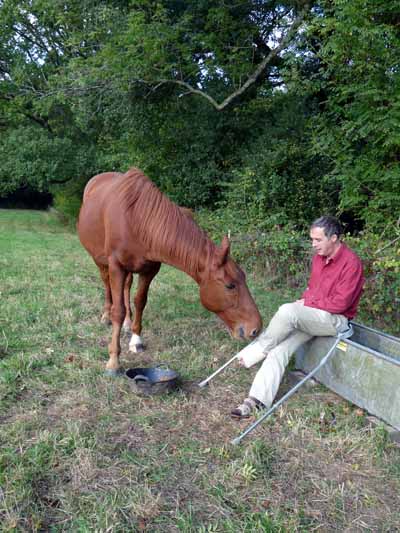 Phil with Jack Daniels
Phil with Jack Daniels
I’ve now been in plaster and using crutches for 5 weeks, and have been making the most of the constrained time to get on with some microscopy projects. Probably at the top of my list of backlog projects was to think hard about the equipment I have, what I actually use, and what I use most. As a result of this soul-searching, I’ve sold some bits on eBay that don’t really ‘fit’ with what I am doing, and then ‘invested’ in some bits to extend the usefulness of the main instruments I do use. Somehow money coming into my PayPal account from sales never seems ‘real money’ and I’ve enjoyed spending it again on other eBay purchases. Of course, it is all too easy to focus on the instrumentation and I have been looking back through the slide collection for rewarding images to photograph. It is interesting how many of the old Victorian favourites still produce the most interesting images with modern instruments and imaging techniques. I hope you like the ‘Pygidium of Flea’.
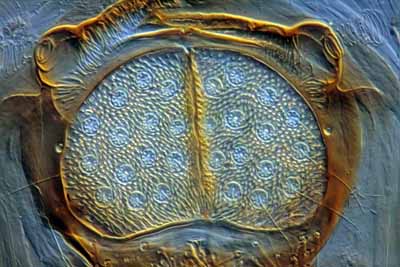 Pygidium of flea
Pygidium of flea
October is one of the most significant months in the Club’s year, with both the Annual Exhibition and the sales day, Microscopium. Despite the crutches, I was able to get lifts to each and thoroughly enjoyed both meetings. The Annual Exhibition had a stunning array of stereo microscopes on display as a special feature organised by Lewis Woolnough, and Joan Bingley made sure we were all organised in advance of the event and on the day. Numbers of traders at Microscopium were slightly down this year but the quality of goods on offer for sale remained high and brisk trade was done, followed by lunch in the local pub – a great chance to catch up with friends that I perhaps see once or twice a year.
It has also been a time to commence our website development project. After some months of planning and evaluation, we have contracted with Cubik, a website development company that specialises in charities and has several medical and scientific charities in their client list. Over the next 4 month period we will be working with Cubik to enter the next important phase in the evolution of the Club’s website, and have some significant new ideas that we trust will be incorporated into the new site. Hopefully launching towards the end of January, we hope the new website will have something for everyone, and enable all members to contribute and enjoy the Club no matter how remotely they live from meetings.
Best regards
Phil Greaves
July 2011
Well, the holiday is finally over and I am slowly returning to the ‘real’ world. The holiday was superb – ‘awesome’ as the Americans would say and we have the photos, books bought, horse-riding gear, biological samples, memories and midge bites to remember it by!
We spent two nights in Chicago, then flew to Salt Lake City to pick up a hire car and spent the next 5 days in Wyoming visiting Yellowstone National and Grand Teton National Parks. We then drove 650 miles south to Moab in Utah for Canyonlands and Arches National Parks, before returning via Salt Lake and Chicago. The scenery in this part of America is almost beyond belief; as an ‘Englander’ I am used to views that perhaps stretch for a few miles, perhaps 30 miles at most. In America, the views were typically 80 miles or more to the horizon and it was fascinating to drive for this distance and only encounter a few cows; no towns or ranches, hardly a fence bisecting the land. One of the more amusing features – and we passed several – were dinosaur ‘quarries’ signposted. The national parks were incredibly beautiful and well-managed by the rangers. I have seen the earth ‘boil’ before in the volcanic parts of Iceland so I knew what to expect in Yellowstone, but the scale of the thermal features was again on a scale like nowhere else. As a microbiologist, I was especially pleased to read notice-boards describing the bacterial mats to the park’s visitors, and to see these people talking about ‘thermophilic bacteria’. The colours of these mats, the complexity of the microbial communities that form them were, again, ‘awesome’. I managed to find a book on the microscopic life of Yellowstone on general sale in one of the tourist offices and will review this in the Club’s Journal.
I refrained from taking too much collecting kit or a microscope with me but did have posted (just in time) a larger mesh net for the large branchiopods (tadpole, fairy and clam shrimps) that I enjoy looking for. Whilst we only had a few hours in Salt Lake City, we made the most of the opportunity and drove out to Antelope Island on the Great Salt Lake. Here I was able to roll up my jeans (too many biting midges for shorts!) and paddle out surrounded by brine shrimps. I knew the populations were sufficient to support a commercial ‘fishing’ trade, but had not appreciated what the experience of paddling through ‘clouds’ of brine shrimp would be like. And in Yellowstone I had a major success, finding clam shrimps (Conchostraca) in a thermally heated pool near the shore of Yellowstone Lake. These are, in my experience, the rarest of the large branchiopods and this completes me seeing the all of the major branchiopod groups in the wild. I can now die a happy man – but preferably in 40 years time!
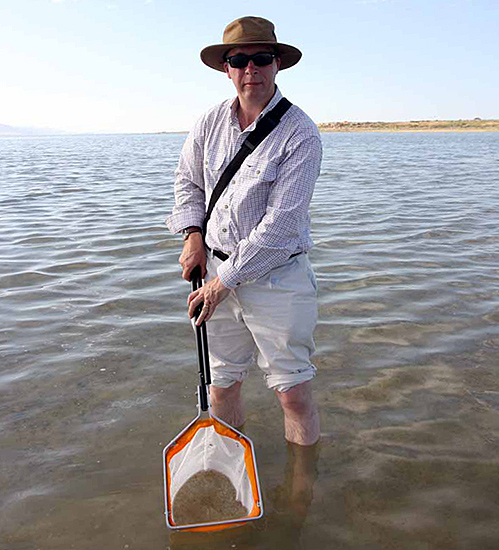 Phil catching shrimps
Phil catching shrimps
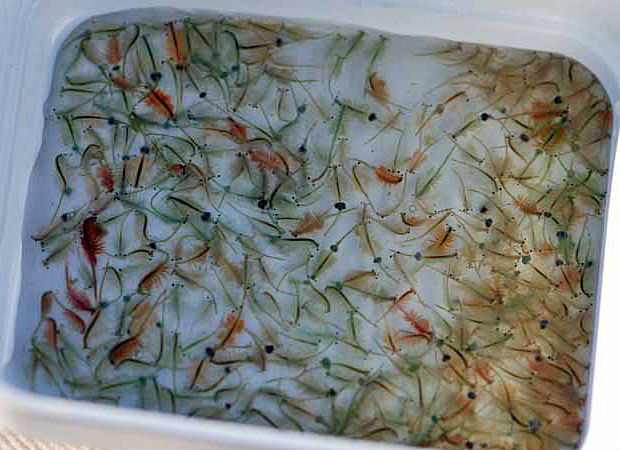 Phil’s catch
Phil’s catch
Finally, we spent our last morning in Chicago at the Field Museum of Natural History. I had visited there some 15 years before on the end of a business trip but wanted to revisit for a special exhibition on the evolution and domestication of the horse. Both the exhibition and the museum in general are superb, but at a combined entry fee of about £18 per person, it did make me appreciate very much the free access we have in the UK to our national museums. In the main hall of the Field Museum is the world’s most complete T. rex specimen, nicknamed Sue. I immediately thought of Allan Brinkworth, whose charming wife is also called Sue – so Allan, this photo is for you! (And Sue, please forgive me!).
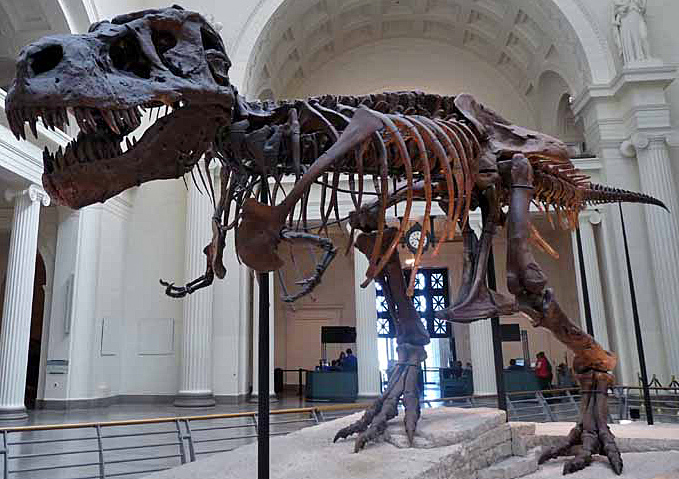 Tyrannosaurus rex
Tyrannosaurus rex
Best regards
Phil Greaves
June 2011
Where did June go? I must admit that I have used the microscopes very little this month, but I have been spending increasing time on the internet looking at ‘microscopical matters’. I have recently joined the Cladocera Interest Group and been enjoying the material – and especially the identification guides – they offer. I have also been sampling pond water for Cladocera in a much more structured way, and preserving samples for identification over the long, dark winter months.
Early in the month I was drawn to the green waters of two large ponds (dug by Capability Brown, or at least under his direction) at Petworth Park in West Sussex. Both ponds have a large population of geese and I was not too confident about what would be present microscopically. How wrong I was! The water contained the most dense population of Volvox that I have ever seen – Volvox soup! They were so dense that I actually had to dilute the sample to examine it under darkfield. I have taken some video and perhaps for my next blog I will learn how to resize this for the website. It has been an interesting start to the pond year, with dense populations of rotifers earlier and now Volvox. Some Hydra in July would be nice!
I have also spent some time this month helping John Wells’ relatives clear his microscopy study, make safe the chemicals, and arrange what to do with the slides. At the beginning of this week I enjoyed a 450 mile round trip (via Norwich to deliver a microscope) to meet up with Steve Gill and pass on John Well’s microscope slides. The drive was enjoyable – the hottest of days, the music playing and an ice-cream en route. It was also good to pass on the slides to Steve (who will be arranging sales of the slides) and recover the space in my car!
At the Club we have been looking at the next stage of development of the website and have had some interesting progress with a commercial organisation that specialises in charities, and has several scientific and medical organisations within their client list. Tony Jarratt, Charles Hussey, Steve Gill and I are working together to define the requirements but we would appreciate any thoughts on what additional features people would like to see.
Anyway, we’re off on holiday in the morning for two weeks, visiting Yellowstone and Utah in America. We have a night in Salt Lake City and I very much hope to get to the Great Salt Lake and look for some of the brine shrimps that the lake is famous for. I’ve even had to buy a new pond net for the occasion; assuming Yellowstone doesn’t erupt, I’ll report what we see in the July blog. Enjoy your microscopy!
Best regards
Phil Greaves
May 2011
Firstly apologies for the late appearance of the May Blog; 5 weekends away in a row have caught up with me. More importantly, apologies for the delay in completing the 2011 Members’ Auction. The response was overwhelming with 1 in 5 members bidding and over 1,500 individual bids placed – entering these into my spreadsheet, completing the analysis and having this second-checked has taken some time (as well as almost sending me blind!). However, all is complete and hopefully every bidder has now received either an e-mail or telephone call indicating their results. Some e-mails appear not to have reached their destination so if you have not heard, please do phone or e-mail. Tony Dutton, Graham Matthews and I have been collating winnings, ‘wrapping and packing’ and have sent about 50% of parcels out now – again apologies if you have not yet received yours but hopefully we should be complete by early June.
I’m not sure where the last 5 weekends went to! Certainly the most memorable was the Dale Fort Marine Plankton weekend. A really great bunch of people, pulled together by Carel Sartory’s organisation, and lubricated with gin and tonic. Even at the Club’s Annual Exhibition, I don’t think I have seen so much high quality equipment in one place before, all brought by the participants. ‘Portable’ instruments included a much-modified Zeiss photomicroscope, three Zeiss Tessovar macro systems (is there a collective noun for Tessovars?) and a good range of Wild microscopes (a personal favourite). Some of the photographs show the range of what was in use – and everyone eager to share equipment, reagents and knowledge. I was able to collect some marine Cladocera which have evaded me for some time (due to the lack of a boat for marine plankton trawls) which I hope to photograph over the summer. I think everyone had a successful weekend, renewing friendships and sharing stories; it was also encouraging to see the participation of professional marine biologists and to share our knowledge of microscope technique with them.
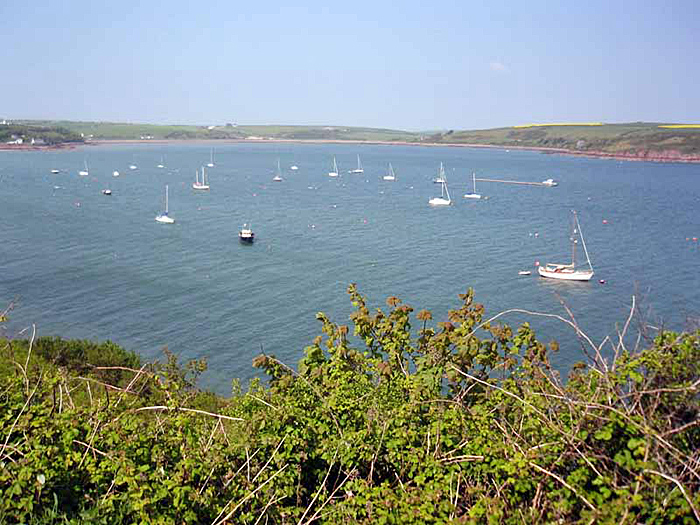
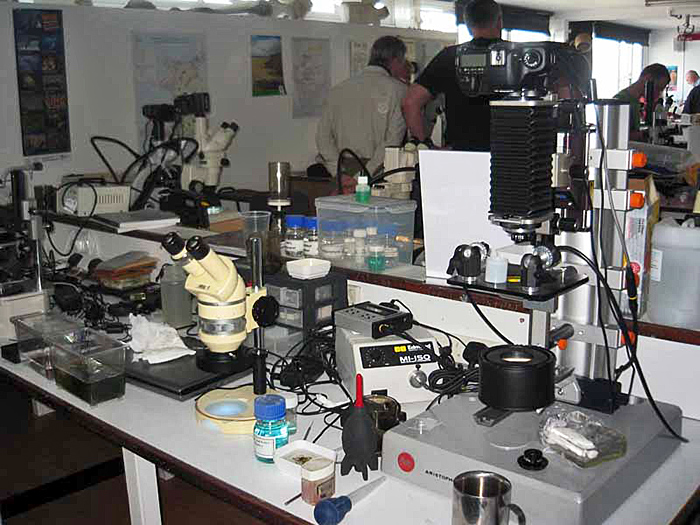
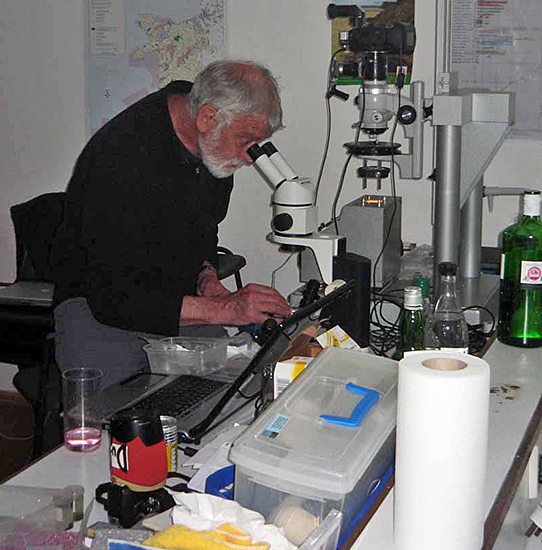
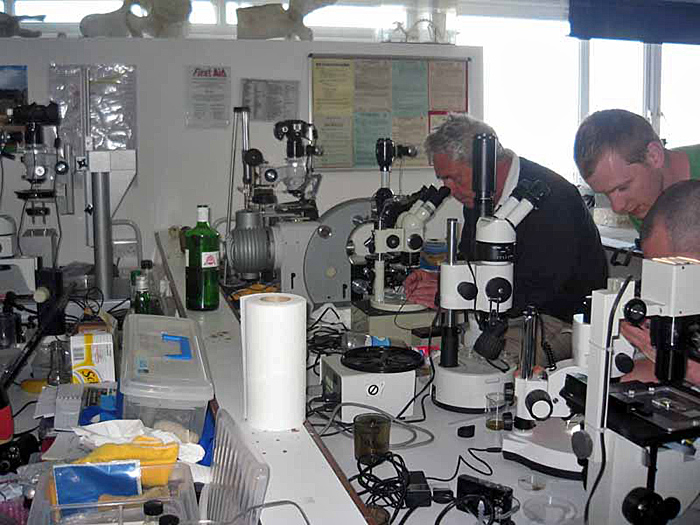
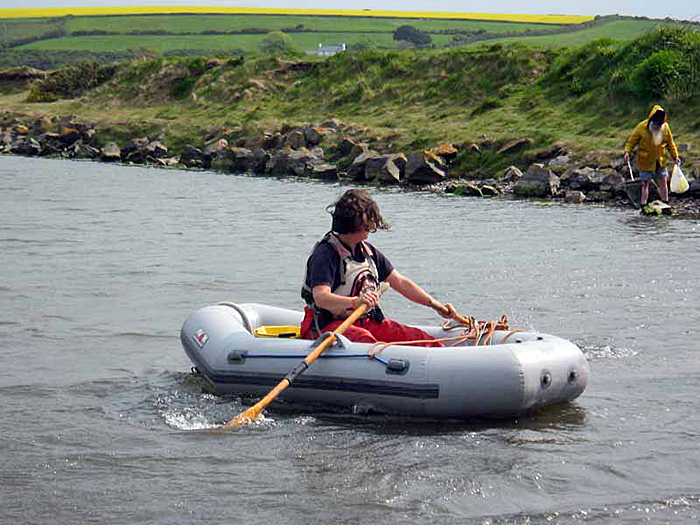
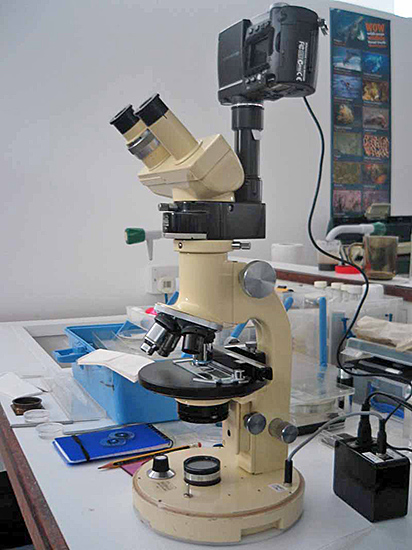
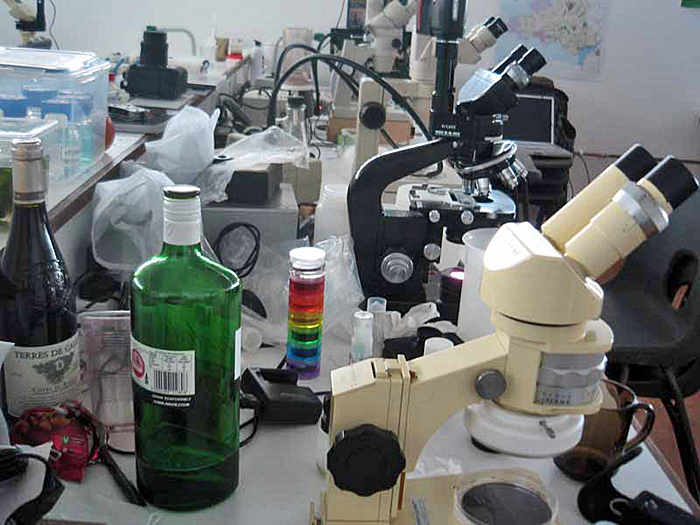
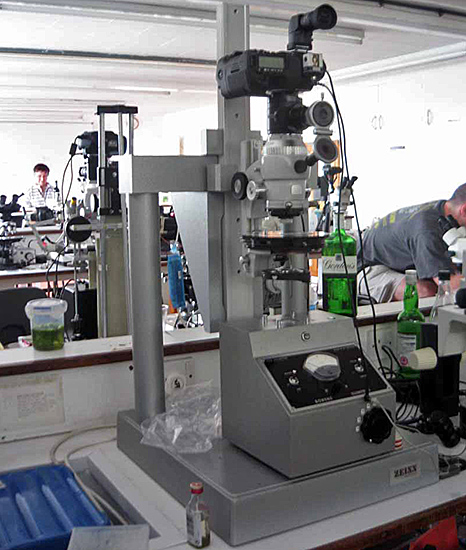
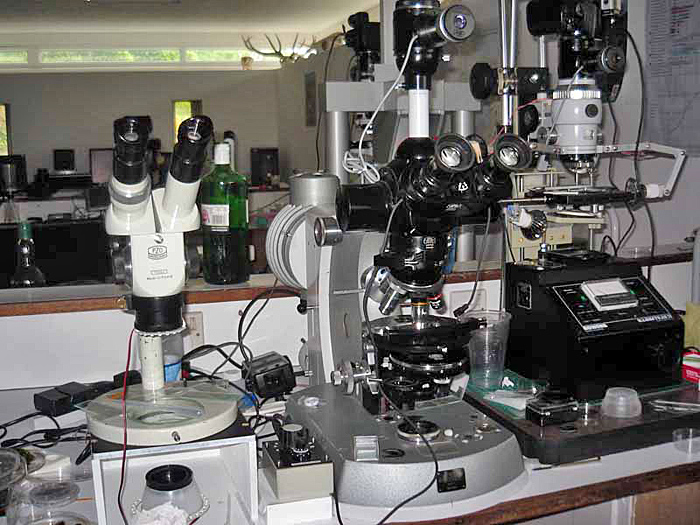
The next weekend was spent in Shropshire, amusing myself with dog walks and pond net whilst Margaret participated in an embroidery course. The ponds that I found were not the greatest, but I found a few Cladocera (still to be looked at) but what did amaze me was the density of rotifers in the samples I took back to our caravan each evening. I don’t think I have ever seen such concentrations before and wonder if it is anything to do with the unusual spring weather this year. Has anyone had similar experiences? I have also had some time in the Lake District, and visited the Freshwater Biological Association’s HQ at Ferry House on Lake Windermere. The facilities look superb, and perhaps we might consider a Club weekend there at some time in the future.
The microscope room is slowly returning to normal after all this activity, with equipment and projects finding their way back into storage (which seems to have shrunk in the meantime). Hopefully June will be a quieter month and I am looking forward to getting down to examine some of the samples of marine and freshwaters that I have collected over the last few weeks.Finally, thanks to everyone who wrote or e-mailed with suggestions regarding the Geoffrey Owen bequest. There were some excellent suggestions which the Committee will review at our next meeting (in late June); I will then be able to feedback which projects we initiate this year and which we perhaps hold for the moment. Exiting times for the Club and I hope your suggestions keep coming.
Best regards
Phil Greaves
April 2011
April has been a very busy month, with some ‘challenging’ issues at work, but more importantly trying to finish off 1,001 microscope projects in preparation for the Dale Fort Marine Plankton weekend.
Although I regularly attend day excursions and ‘pond dips’ somehow a weekend requires ten times as much equipment. Projects that have needed completion vary from removal of the previous owner’s sticky labels from the Wild M5 stereomicroscope (bought in November but only cleaned of sticky labels last week) to more complex engineering of two portable macro rails for the anticipated photography of marine invertebrates. Quite why I have left some of these projects for so long is a bit of a mystery to me but that is the advantage of attending a meeting; it does force the issue!
I am actually writing the blog over a few relaxing moments with a Belgian beer in Amsterdam airport, waiting to fly home. I should be back home around 7:00 p.m. and have the horse to feed and water – and then finish the last parts of the macro rail system in time to leave home again at 7:00 a.m. for the journey to Dale Fort. I’ve been in Amsterdam for two days this week for work, and had the chance of a couple of hours sight-seeing this afternoon. It has to be one of my favourite cities with the canals, 17th century buildings (I can easily imagine Leeuwenhoek’s life in Holland) and the multitude of small, interesting shops. I found antique microscopes for sale in three shops all within a half-mile radius of my hotel. Where else in the world can you walk into a shop and buy an immaculate shagreen leather Culpeper microscope….for 15,000 Euros! If ever you do find yourself in Amsterdam, do at least window-shop at Meulendijks & Schuit’s amazing shop on the corner of Nieuwe Spiegelstraat – or visit their website at www.staetshuys.nl.
Last week I received a parcel through the post that brought me great pleasure – not so much for the content (a LED ringlight for the Wild stereo) but for the parcel itself. Sent from Hong Kong, it was covered with important-looking airmail and fragile stamps, the postage stamps themselves were of colourful Chinese birds (saved in aid of Guide Dogs for the Blind) and secured with string. Everything a parcel should be, and received from Hong Kong only four days after ordering. So, Mr. Jim Wang if you are reading this, thank you very much for your superb service.
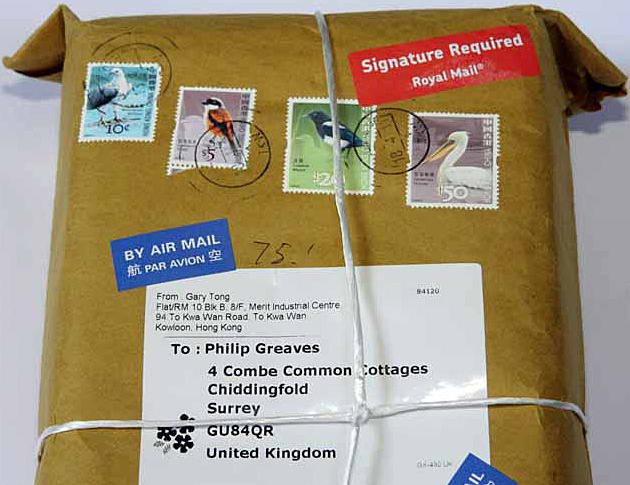 Parcel from Hong Kong
Parcel from Hong Kong
Just time now to buy some duty-free gin (I understand this is an entry requirement for Dale Fort) and wander down to the pleasures of an EasyJet flight back to Gatwick; I look forward to hopefully sharing some pictures from the marine plankton weekend in my next blog.
Best regards
Phil Greaves
March 2011
Is there a Guinness world-record for the number of microscopes squeezed into one car? Obviously this would need some rules both on size of microscope and size of car; Leeuwenhoek microscopes in a people-carrier would clearly win over Zeiss Ultraphots in a Mini. I ask because early in the month I had 21 full-sized, cased instruments in my car for sale at the Reading Microscopical Society’s meeting. Fortunately, the microscopes were not mine and were being sold on behalf of others, and only two came back home again.
Both the Cobham and Reading meetings were a great start to the year’s meeting calendar, allowing friendships to be renewed after the winter months, and hearing some excellent lectures on both favourite and new topics (I have learnt much about sex in jellyfish, which is a subject I had not previously considered!). The Cobham meeting provided a unique moment for the Club. 6 out of 7 living Presidents attended the meeting (Ven Dodge, Brian Bracegirdle, Brian Davidson, Bruce Scott, Maurice Moss, Pam Hamer and myself) and the opportunity to capture the moment photographically was not missed.
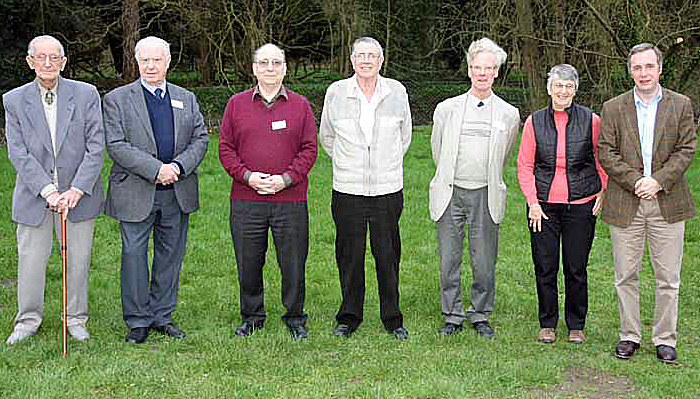 Seven Presidents of the Club
Seven Presidents of the Club
I am now starting to plan for the Dale Fort Marine Plankton weekend in May, organised by Carel Sartory. I have wanted to attend the meeting for some years but circumstances have previously transpired against me so I am really looking forward to the weekend. I am not quite sure what to expect but I understand it involves possible drowning (or at least a dunking) at sea, various narcotics (sorry, narcotising solutions) and copious gin and tonic – a recipe for an ideal weekend!
Finally PayPal has at last agreed that I am not a Cuban criminal and restored my account after 5 months, multiple phone calls, and more proof of personal identity than I thought possible. I am now back to trawling eBay for those elusive bargains and have just bought a fluorescence filter set for my Leica. I must not get too involved in trying this out as I really, really must prepare for my Presidential Address in May!
Best regards
Phil Greaves
February 2011
Finally the flies thought it was safe to come out again in the microscope room and I was able to ‘sacrifice’ one using ethyl acetate to try the StackShot system in anger. In the end it wasn’t necessary to decapitate the fly, which was impaled on one of my wife’s embroidery pins and positioned with BluTack (a most useful microscope accessory).
After some initial trial and error I was able to programme the StackShot macro rail to divide the distance between lower and upper focal points of the fly’s head by 100 (a number I programmed for roundness rather than any scientific reason), and then leave the system to advance the focus and fire the camera shutter for all 100 steps. After another cup of tea whilst Helicon Focus combined the 100 stacked images, I was presented with the following final image. It is not perfect, but as a first attempt I am pleased with it and, whilst the StackShot does not do anything that cannot be replicated manually, there is a huge element of fun in setting it up and sitting back while it does its thing.
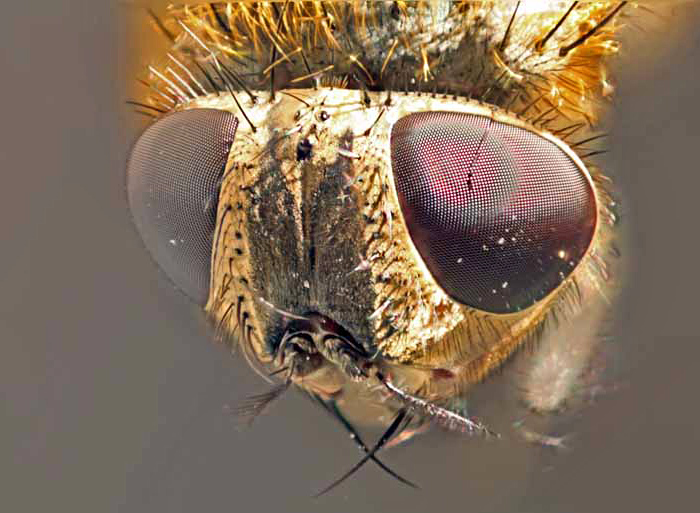 Head of a fly
Head of a fly
I hope you like the image (and I appreciate that fly head aesthetics may not do it for everyone). I am very much looking forward to some more image recording with the system and will report back results.
Technical note: The 100 images making up the final stack were taken using a Canon EOS 5D Mark II digital camera, attached via an adapter to an Olympus bellows with a Leitz Photar 25mm focal length macro lens (via another adapter). Illumination was by a twin arm fibre optic light, diffused through a shade made from a table-tennis ball. The images were combined with Helicon Focus; the final image has not been processed further.
Since taking the first pictures, I have also been exchanging e-mails with Spike Walker about his StackShot set-up and comparing notes (surely this is one of the great pleasures of the Quekett, discussing and learning from others) and I have again modified my macro set-up to accommodate the benefit of a Leitz Aristophot transmitted light stage. This works much better than my initial system, although now I need to find or make stage inserts for the Aristophot stage as these are missing from my system (anyone got a spare set for sale?)
During the month I also enjoyed a week off work (sheer bliss!) and spent my days with a cement mixer laying brick paths in the vegetable garden (another overdue project). I finished late afternoon each day and then had a clear mind (and a tired body!) to catch up on some of those long-term microscopy projects. One of my main achievements was to finish off a tray of amber slides that needed cleaning, ringing and labelling. Surely there is nothing as satisfying as seeing a tray of slides that you have mounted yourself!
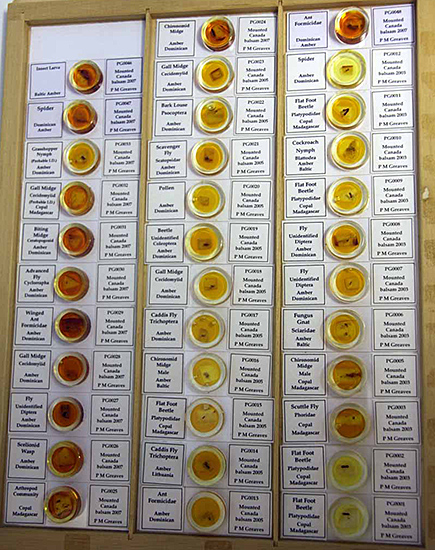 Tray of amber slides
Tray of amber slides
I am now looking forward to March, and the proper start of the microscopists’ year, with the Cobham regional meeting, Reading Microscopical Society’s annual meeting, and the Club’s AGM.
Best regards
Phil Greaves
January 2011
As well as wishing everyone a Happy New Year, I must apologise for missing the December Blog. Several things conspired against me at the same time. The combination of newly acquired horse and freezing snow meant twice daily visits with hay and ice breaker for the horse trough, and I have suffered two computing problems. Firstly, the British Telecom modem decided to stop working and had to be replaced. The work laptop found the new wireless network easily, but my home desktop PC flatly refused to acknowledge its existence. It is amazing how much time computers absorb when the don’t work as they should.
The second issue is with PayPal. Without thinking, I tried to use PayPal whilst working for a week in Cuba, and had my account restricted (frozen) as Cuba is a high risk country (and no doubt due to the US trade embargo). Dealing with PayPal has been an endless round of requests for proof of identity and address (requiring a total of 7 bank statements, passport photocopies, utility bills etc. to be provided). Much time (and no doubt money) has been spent on the phone trying to resolve the issue with PayPal but still 2 months later the saga continues.
On a brighter note, spending 10 days at home over Christmas was bliss; I can only imaging this is how enjoyable retirement can be, but I have a long way to go (both in years and financially) before I can get there. I used the time to tackle a pet hate of mine; trailing electrical cables! It seems that microscopy now involves multiple devices each with its own electrical lead and plug. With computer, twin monitors, scanner, printer, stereo and compound microscopes, camera controls etc. I have a need for 14 sockets! So Christmas was spent rewiring sockets and cutting trailing leads to the required length. Like all DIY jobs, it took longer than anticipated, but the time was very well spent.
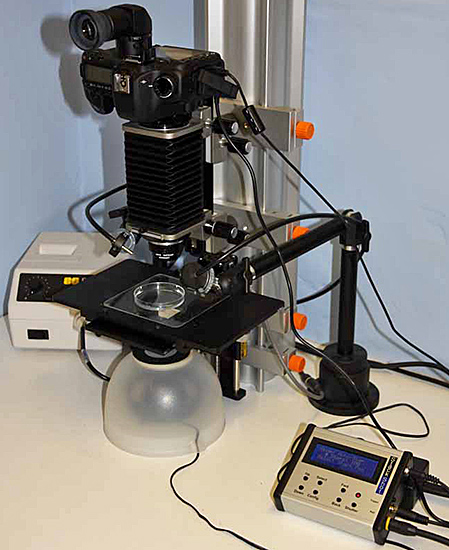 StackShot and macro stand
StackShot and macro stand
I also completed the initial set-up of the StackShot macro rail. For those who missed earlier blogs, this is an automated system for stacking macrophotography and consists of a macro focus rail driven by an accurate stepper motor, and a controller that advances the focus rail, triggers the camera to take an image, advances the rail again etc. for the desired number of ‘steps’. Having assembled the system, it has been amazing how all the insects disappeared. The loft room where I have the microscopes is usually a good source of overwintering flies but as soon as my thoughts turned to dipteran decapitation (for the photography of course!) there has not been a fly to be seen. I therefore had to use as my first trial subject a fairy shrimp immersed in glycerol which has proved problematic to illuminate without flare or ‘ghosting’ of the light source.
I will add some final pictures to the blog once I am happy with them. However, from current results, this may take some time!
Best regards
Phil Greaves
November 2010
Whilst October was busy with Club events, November has also been a busy time.
Early in the month I attended the OPAL project (Open Air Laboratories – a Lottery-funded scheme running for 5 years to promote amateur and natural history societies’ participation in biodiversity) annual conference at the Natural History Museum. This was a superb event, and reinforced the role the Club has to play in developing microscopy skills with amateur naturalists, and the contribution we can make to the understanding of microscopic life. It was also encouraging to see so many enthusiastic people in their early 20’s attending.
A not-so-pleasant task was helping clear the microscopic effects of our member John Miles of Worthing. John had recently died and asked in his will that the Club helps sell his equipment to raise funds for the beneficiaries of his will. This is a service that I think is important that the Club provides – and it is always good to help people dispose of the chemicals that many of us accumulate or use. John’s equipment will join others in a Members Auction that I hope to have catalogued by the end of the year.
The month has ended with me enjoying another week of working in Cuba – a wonderful and fascinating island, and it is good to catch some sun before returning to the British winter. I am writing this blog from my hotel room, with the sound of the sea crashing ashore only 40 yards away, with a Cuban beer at the side of the laptop – life can be tough!. The long flights have also allowed me to catch up on some reading, and I saved the last issue of the Journal specifically for the trip. What a superb blend of articles were in the Journal, and all so well researched. I look forward to the next issue, and I have some articles in mind to contribute.
November also saw my birthday (21 again!) and I was finally able to open the StackShot macro rail system. Unfortunately I have not yet had time to assemble or test it due to the Cuba trip, but first impressions upon opening the box were very favourable. The main components of the system – the macro rail with stepper motor and control box – are very well-made and solidly engineered. All the connecting cables are provided, along with a CD instruction manual. There has been some criticism on some web-forums about the camera clamp screw, and the system can now be specified with an Arca quick-release plate. I opted to retain the screw as I hope to mount the specimen stage, and not the camera, to the StackShot rail, and hope I can make a more permanent (and secure) arrangement this way. Hopefully I will have more to report on the system in my next blog.
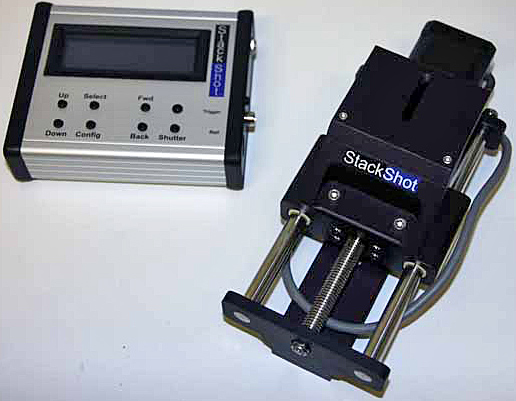 StackShot with controller
StackShot with controller
Finally, I have a new distraction from microscopy in my life. After a gap of some 25 years, I am back into horse ownership having recently bought an Irish Hunter called Jack Daniels (what a superb name – even though I prefer genuine Scotch!). For those who know of such things, he is 16.1 hands high and just under 6 years old. No doubt I will be able to link him to microscopy. Does anyone have a protocol for counting helminth worm eggs in horse droppings?
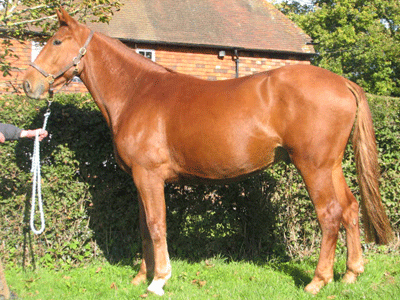 Jack Daniels
Jack Daniels
Best regards
Phil Greaves
October 2010
For me, October is the highlight of the ‘microscopical’ year with both the Annual Exhibition and the sales day, Microscopium.
For once, arrangements with the Natural History Museum for the Annual Exhibition went like clockwork (thanks Charles!) and I turned up at 7:00 a.m. on the Saturday morning ready to do my ‘assembly’ duties, only to find that the Friday team had nearly completed everything. It was strange wandering around the exhibition area on my own for over an hour, making minor adjustments to tablecloths, waiting for the event to commence.
We had a full range of exhibits and I am always encouraged by the diverse nature of members’ interests, and in awe of the ingenuity displayed by those who invent and fabricate apparatus to such high quality. The total number of visitors was down slightly, reflective of the costs and hassles of travelling into London, but we had over 120 members and guests through the doors, and the smaller numbers provided much better opportunities to chat with friends who I see only once or twice per year.
I was particularly pleased to meet Budd LaRue from California (Budd commented that he had last been to the Exhibition some 17 years ago – and how many faces from then were exhibiting this year!) and my dear friend Klaus-Peter John who visits us every year from Germany. Klaus very kindly gave me a recently published book on an exhibition of Moller slides held in Germany last year. Printed in German, it is going to stretch my long-distant O-Level German! Klaus also kindly sent me a CD of photographs of the Exhibition, together with this superb photo-montage. Thanks Klaus!
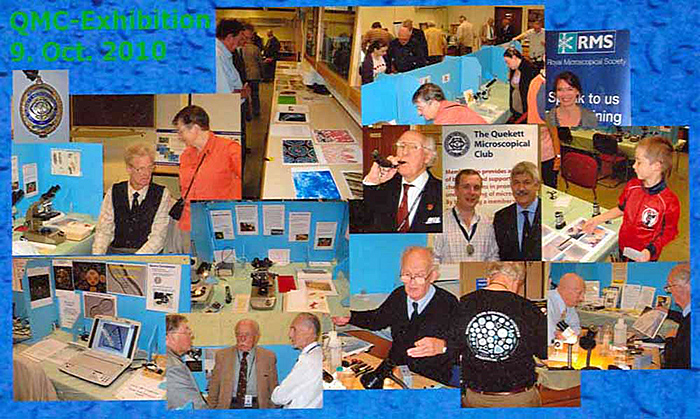 Photo-montage by member Klaus-Peter John
Photo-montage by member Klaus-Peter John
Microscopium is a very different event, requiring several nights of pricing up and loading of microscopical equipment into the Land Rover. This time I managed to navigate the roads of St. Albans successfully and arrived just before 9:00 a.m. to find the event almost in full-swing! Many of the items that I had for sale were from a dispersal of Dick Hamond’s estate, with Stephen Livermore selling the larger items. Together we raised several hundred pounds for Dick’s brother, and found grateful new homes for most items; I look forward to seeing these items at microscopical events around the country. Other items from Dick’s estate will be sold via Club auction so look out for the catalogue being issued later this year (once I have had chance to write it!).
For the last few years I have gone to Microscopium planning not to buy anything but have always found something of interest. This year it was a Wild photomicrographic system which I bought simply for the inter-connecting cable! At £10, surely a bargain for a system that probably cost well over £1,000 20 to 30 years ago. As ever, I now have a Wild photomicrographic system surplus to requirements, minus its cable!
With these two events out of the way, I can now return to projects at home. I have been watching the StackShot macro rail system for some time. Spike Walker first introduced me to it – the system automatically advances a macro rail at set intervals, and automatically triggers the camera shutter at each step, for use in image stacking. I have persuaded Mrs. Greaves to buy one for my birthday – it is now on the ‘high seas’ from America. I am now spending my time reading Photonics catalogues to order the parts needed to integrate it onto my macro stand. Hopefully more of this next month once I have the system assembled.
It is surprising how relaxing a Photonics catalogue can be when read in bed!
Best regards
Phil Greaves
Webmaster’s note – If you would like to see a StackShot macro rail visit the website of the manufacturer – Cognisys Inc. (www.cognisys-inc.com/stackshot/stackshot.php)
September 2010
My apologies to anyone who reads my blog for the absence of an entry for August; part of the month was spent on holiday in Australia where we enjoyed Kakadu National Park (near Darwin) in the ‘Top End’ as the Australians call the north. We then travelled south to Perth for time with my wife’s family. All good fun but no time or opportunity for microscopy. I did manage to take a pond net in the hope of finding some brine shrimps in the salt lakes and I brought back one preserved sample which contained some interesting crustaceans – not brine shrimps but with amazing leg growths which I assume can act as paddles. I am sure I have seen a photograph of these before but cannot locate it at present. Does anyone know more about these?
I came back from Australia and within 10 days of arriving home was off to India for work, from where I am currently writing. In between I did meet up with Brian Bracegirdle and his wife Pat at Hobbs in Southampton, who publish the Journal. This was fascinating visit; Hobbs make major investment each year in the latest equipment and have all stages of production in-house. A most impressive company and we are fortunate indeed to have the Journal printed by a company of this level of professionalism. The main reason behind my visit was to collect the main stock of Brian’s latest book, published by the Club; A History of Photography with the Light Microscope. The drive back from Hobbs with 400 copies of the book was ‘cautious’. I knew the Land Rover sagged slightly as the boxes were loaded but it was only when I arrived home and weighed one box that I realised I had driven with nearly half a tonne of books! It was good exercise moving these into storage.
I have taken my copy to India and it has been a constant companion during the 30 hours of air travel. The book is superb in its content and stunning in the use of illustrations. As the advertising men say: Now available via the Club Shop at discounted price to members and via Savona Books for non-members.
India has been interesting and also intensive. I have at last today (Saturday) had time to myself and travelled to the Botanic Gardens in Calcutta. According to the book these are the ‘second largest gardens in the world’ – I always seem to end up at the second or third largest of something, and never learn which is the largest. So I was pleased to see the world’s largest tree in terms of circumference, a banyan tree (Ficus). Although the main trunk has now gone, aerial roots and trunks now extend over a 3.5 acre area.
The gardens are easily on the scale of Kew or Kirstenboch in South Africa, but could politely be described as ‘naturalised’. The gardens contain a large number of ponds and lakes which must have been of great interest to the Victorian and Edwardian naturalists who visited or worked in the area. Indeed, there are many publications of the period describing microscopic life in India. But as I looked out at what I can only describe as a pond-dipper’s paradise, I wondered what rotifers, Cladocera, gastrotrichs, desmids, diatoms wait to be discovered. I have my sample (I take a simple sampling kit based on a plastic turkey-baster wherever I go) and look forward to getting home late tomorrow to get it under the microscope.
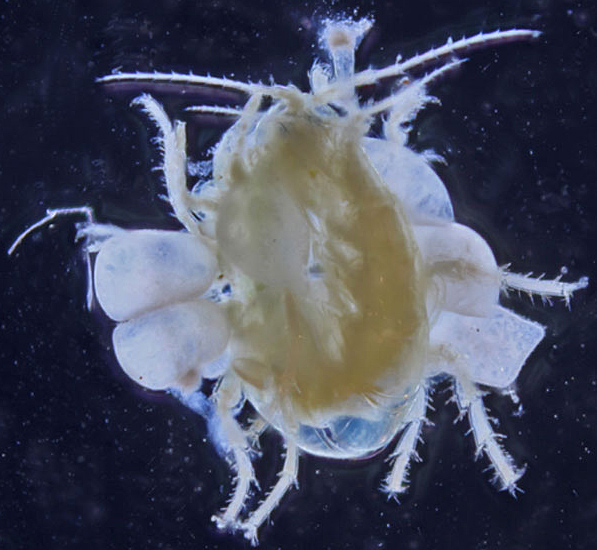 Copepod from salt lake in Western Australia – note the unusual ‘paddles’ for swimming
Copepod from salt lake in Western Australia – note the unusual ‘paddles’ for swimming
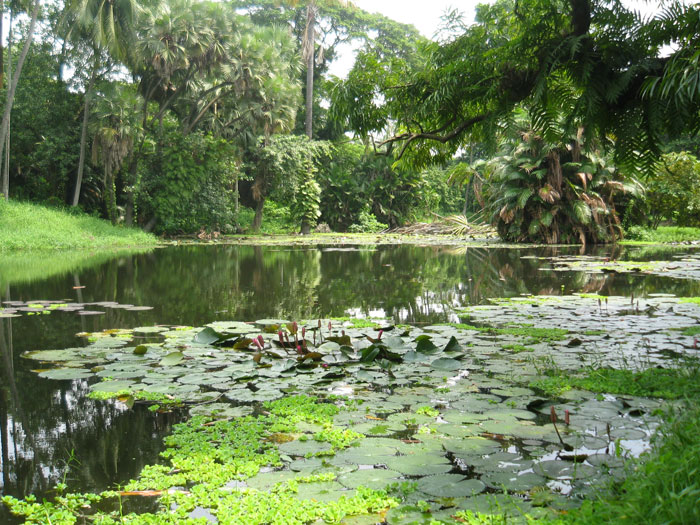 An Indian pond-hunter’s paradise?
An Indian pond-hunter’s paradise?
Best regards
Phil Greaves
July 2010
Both June and July have been busy months! We finished June and entered July at the Royal Microscopical Society’s MicroScience conference and exhibition in London, where Graham Matthews and I manned the Club stand for three days, supported by a healthy number of different Club volunteers each day.
The exhibition was superb, with the latest imaging systems (‘microscope’ now sounds too simple a word to describe the integration of optics and electronics) and a bewildering array of techniques demonstrated. Despite all this modern technology, and the cost of it all, it was rewarding to see how many professional microscopists stopped dead in their tracks at the quality of images taken and displayed by Club members on the Quekett’s stand. We met some interesting people, signed up some new members, and made significant progress in increasing the Club’s profile in the microscopy community. And we had some fun at the Argentinian bar in the evening!
Soon after this we held an open afternoon at the Natural History Museum for scientific and volunteer staff. This again required a lot of preparation of posters and display material, and was very well supported on the day with members’ Gossip exhibits. I was unfortunately unable to attend due to another business trip, but the reports back are full of enthusiasm for this event.
During the month I also had the opportunity to call in on Spike Walker – and his partner Chris – whilst en route for work along the M6. It is always a delight to see Spike. His robust sense of humour matches mine and I always come away with an aching jaw from the laughter. Seeing Spike’s work and his latest projects is always an inspiration and II both get enthused about photographic possibilities, and learn more each time about how to achieve them.
This time Spike introduced me to an automated macro rail with stepping motor to advance the camera for ‘focus stack’ macrophotography. Made by StackShot, this system seems to have great possibilities and I hope Spike will write a review for the Club on his experiences with the system. Finally seeing the amount of (Zeiss) equipment Spike has (see the picture) always makes me feel better about my own ‘magpie’ habits!
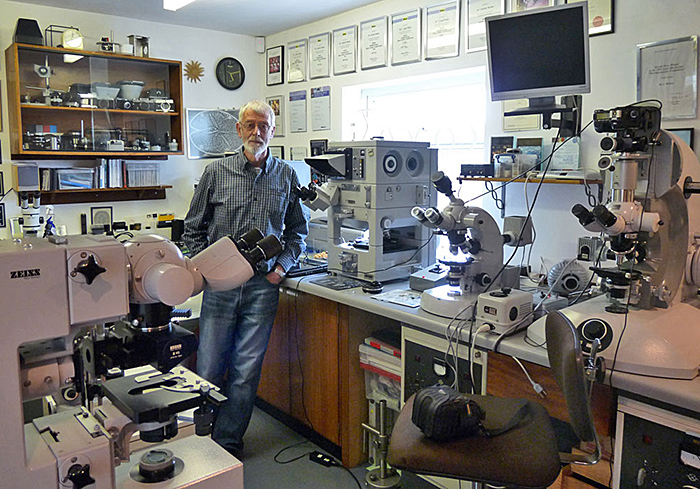 Spike Walker and his microscopes
Spike Walker and his microscopes
We’re off on holiday soon to see relatives in Perth, Australia and have an ‘outback’ trip by four wheel drive from Darwin for a few days. I am currently enjoying putting together a small pond sampling kit for the journey (the only holiday preparation I have made so far!). Whilst Darwin will be hot and dry, Perth will be at the end of a rainy winter so I hope to find and examine some of the fairy shrimps (Branchiopod crustaceans) that inhabit the salt lakes and temporary waters of the area. I shall report back at the end of August. I hope you enjoy your summer!
Best regards
Phil Greaves
June 2010
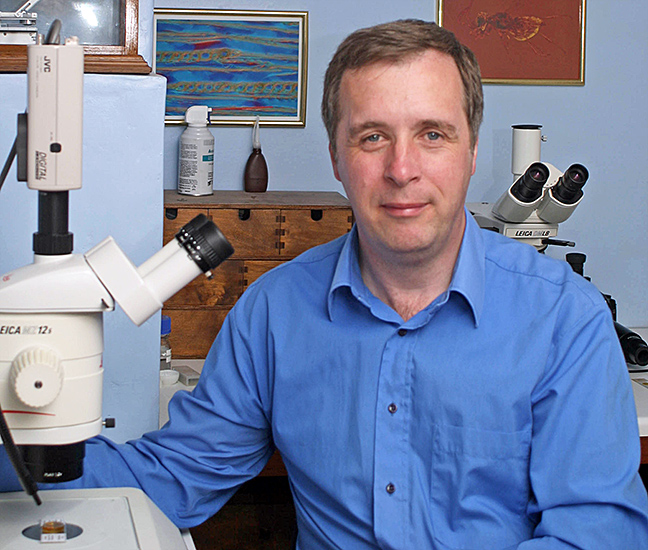 Phil Greaves
Phil Greaves
A very big welcome to our new website! Many months of planning and work have gone into making this happen. The new website ‘breaks away’ from the Natural History Museum’s server, which has served us so well to date; our new server provides greater flexibility and quicker updates. Hopefully you will find the new ‘architecture’ of the website much easier to follow, and our new searchable index will help you find that essential archived article.
The success of the new website depends on you. Visit the website frequently, and you will be entertained with new material on a regular basis. Why not send a short article, or some photographs of your work. If you have a question, or a comment, please use the Forum. Finally, the website will continue to evolve – nothing in ‘cyberspace’ is static for long! Tell us what you like about the website, and perhaps what does not work so well. What else would you like to see?
It has been a busy time for the Club. In addition to the new website, we have been preparing for the Royal Microscopical Society’s MicroScience exhibition at the ExCeL centre in London, 29 June to 1 July. The RMS has generously provided a stand for the Club, for free. Much work has gone into preparing for the exhibition, designing and printing new brochures, posters and exhibition stands. We hope to attract some new members to the Club through this route; if you are visiting the Exhibition please do call in and see the Club’s stand.
We have also earlier in June supported the Natural History Museum’s open day at the Wildlife Garden in London where we mounted a ‘Young Scientists’ day with pond dipping and use of the Angela Marmot’s Biodiversity Centre’s microscopes. The day was very busy with both adults and children – we nearly had to push out interested groups at the end of the day! Our next activity that we are preparing for is an open day for scientists and volunteers at the Museum, to illustrate the work of the Club and our members. Busy times, but promoting the Club and attracting new members is vital to the Club’s ongoing success.
I have today commenced a new project (another one!). Whilst I understand there are some members who are not excited by freshwater life under the microscope, as a biologist I have always enjoyed a ‘pond dip’ and I suspect many microscopists have a pond at home for that very purpose. Unfortunately for me, a pond has never really fitted into my garden planting schemes. However, yesterday whilst visiting our local agricultural merchants, I was attracted to a small (new) galvanised cattle water trough. It fitted into the back of the Land Rover (just!) and today has been set up as my microscopists’ pond with a couple of pond lilies (yes, it has to look attractive as well!) and a bucket of water and weed from a local pond. I look forward to reporting on what develops.
Best regards
Phil Greaves
November 2009
Algae Everywhere! I receive a number of scientific publications for work and generally browse through them in the ‘twilight zone’ on a Friday evening as the working week winds down and the weekend begins. This month there have been a number of interesting articles on algae. Laboratory News carried an article on the potential involvement of algae in the mass extinctions that have occurred during history. Certainly everyone is aware of the theories about meteor-strikes being the most likely cause of the dinosaur extinction, and the possibility of ‘super-volcanoes’ being linked to other events.
Researchers in Italy now believe that algae may have been the main culprits. Their theory is that the atmospheric dust generated by one of these events, once it settled into aquatic environments, will have triggered a massive explosion in the algal population due to the increased nutrients. This may have led to increased algal or cyanobacterial toxins resulting in the deaths of both aquatic animals and of herbivores that require large volumes of drinking water, with the subsequent collapse of whole ecosystems. An interesting theory, certainly supported by the toxic algal blooms that have been reported in recent years.
More positively, Nature ran a lead article titled ‘Gold Rush for Algae’. For some time oil giants and others have been looking for alternative renewable fuel-sources. Whilst biofuels from agricultural crops are making some contribution, their widespread use would divert land away from food production; the sums simply do not add up. Enter algae, and the possibility of growing algae on non-agricultural land and harvesting oils and alcohols from the algal cells that can be converted into advanced biofuels.
According to Nature, more than $1 billion has been invested in algae-to-energy research and, whilst large scale quantities of fuel have not yet been produced, results so far look promising. The algae are either grown in large open-air lagoons, or under more controlled conditions (although more expensively) in bioreactor systems. Work is also taking place to identify and isolate high-yielding species and strains of algae, and the use of genetic manipulation techniques to enhance productivity.
So, next time you look at pond-water down your microscope remember; you could be looking at the future of our planet! On a personal note, we’re off to spend some time with relatives in Perth, Western Australia in a few days. I’m hurriedly trying to assemble collecting equipment and sample bottles for some tardigrade work and I hope to visit some freshwater stromatolites. Assuming the spiders don’t get me, I shall report back in the December blog. Enjoy your microscopy!
Best regards
Phil Greaves
October 2009
It has been some time since I updated the ‘blog’ – September and October have been busy months! For me, two of the most enjoyable events in the Club’s calendar are now behind us – the Annual Exhibition and Microscopium – and it is time to relax and enjoy my microscopy.
The Annual Exhibition is always a worry – will there be enough exhibits and will they be interesting? Like many events most contributors seem to come forward only in the two weeks prior to the event itself and it has always been ‘alright on the night’.
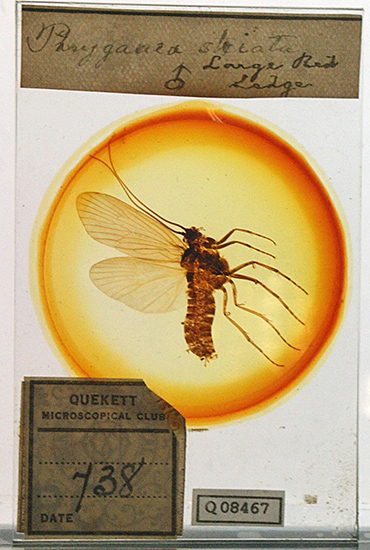 Oversized insect mount
Oversized insect mount
This year the diversity of members’ exhibits seemed even more interesting than previous years and it was good to have some of the Club’s collections on display for all to see. I was particularly impressed by the oversized slides of insect mounts – they’re not necessarily that good under the microscope but certainly have a visual impact on display. One of the highlights this year was the guided tour of the Museum’s Bryozoa section kindly led by Mary Spencer-Jones.
Mary was keen to tell us that she is the only dedicated full-time curator of Bryozoa in the world! She certainly entertained with her knowledge of the subject and the collections on display were simply superb. They included material collected by Charles Darwin and mounted onto slides by George Busk, one of the founders of the Microscopical Society of London (now the Royal Microscopical Society). Very different in nature, and following only two weeks later, was Microscopium, the Club’s sales day. Despite arriving over two hours late due to a navigational disaster (I must remember to buy a ‘sat-nav’ for the car and not another objective!), I had a successful time selling items on behalf of the son of a Club member from Northern Ireland. We had met up in motorway services on the M6 in the Lake District earlier in the year (this being approximately half-way between Belfast and Surrey!) and furtively loaded microscope cases and boxes of accessories in the car-park, much to the interest of other road users. The day after Microscopium is always the greatest pleasure; being able to tidy up the microscope room after months of chaos. All is neat and orderly now, but I am sure it will not last!
Best regards
Phil Greaves
August 2009
The holiday in Italy was a complete success; the microscope with its newly installed LED lighting performed superbly and I was able to cut and polish a large quantity of amber – interspersed with viewing the local towns and villages and enjoying some of the wines for which Tuscany is famous.
As predicted, the microscope caused the usual confusion for the X-ray operators at both Heathrow and Pisa airport. In Heathrow, we and the microscope were swabbed for explosives by a large and slightly daunting security officer; the experience in Pisa was much more pleasant with two young uniformed lady officers. We were let out of the county as soon as one could declare to the other ‘aah, mikroscopio!’.
We visited a superb natural history museum in Sienna, the Museo di Storia Nutural. Everything a traditional natural history museum should be, with the added bonus of an entire gallery of terracotta models of fungi made by Francesco Valenti Serini who lived from 1795 to 1862. Over 800 pieces are on display, from a total collection of 1,800. Simply superb! I also discovered an interesting phenomenon in the main Duomo (cathedral) in Tuscany.
Using a ‘compact bridge’ digital camera, I was trying to take a photograph of the ceiling of the central dome. On the viewfinder I could see a series of series of red lines tracing across the base of the dome which were not visible by eye, or on the completed picture. Presumably these were infra-red security beams but why were they detectable only on the viewfinder?
Onto other matters. On the way back from a business journey to Torbay, I took the opportunity to call into the Somerset village of Langport to collect some microscopes that have generously been donated to the Club to aid proceeds. Langport as many members will know is the birthplace of John Thomas Quekett and I was kindly guided to the graveyard of All Saints’ Church where John’s parents William and Mary are buried, alongside the grave of their second son Edward who became a banker.
It was a humbling experience to stand before these graves; I hope the family did not mind me acquiring a small piece of moss from the gravestone to look for tardigrades. Somehow it seemed a symbolic thing to do.
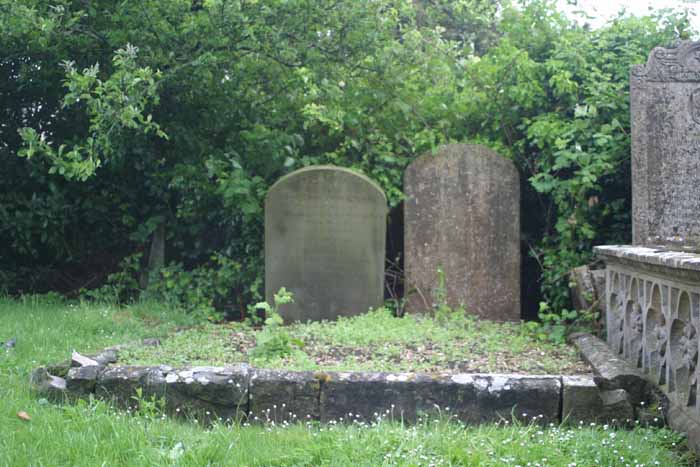
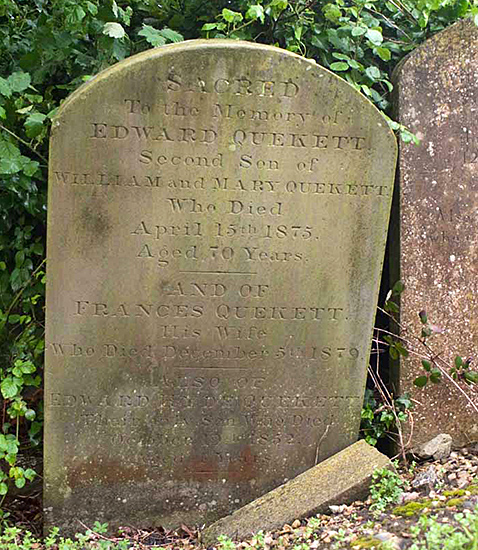
The grave on the right side is that of the parents William and Mary. The inscription is fading badly but reads ‘? ? Lie The Remains of William Quekett. Son of this Town, he Died 12th August 1842 Aged 79 Years. Also of Mary His Wife who Died 2? March 1842 Aged 67 Years’.
The grave on the left is in better condition and reads ‘Sacred to the Memory of Edward Quekett, Son of William and Mary Quekett who Died April 15th 1875 Aged 70 Years. And of Frances Quekett his Wife who died December 5th 1879. Also of Edward Hyde Quekett Their Only Son who Died October 19th 1852 Aged 4 Years.’
Best regards
Phil Greaves
July 2009
Firstly I must apologise for the lateness of my blog this month. As you may recall, I have been experimenting with LED illumination for the ‘maid of all work’ stereo that I use for cutting and shaping amber. Like all projects, this has taken much longer to reach completion than anticipated – and certainly not helped by starting two other projects at the same time! More of these another time.
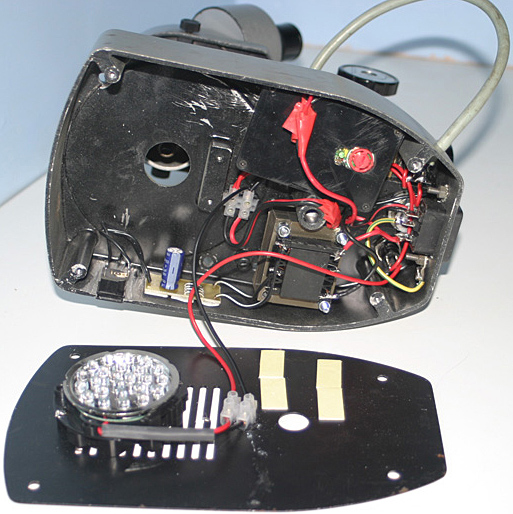 LED conversion in base of stereomicroscope
LED conversion in base of stereomicroscope
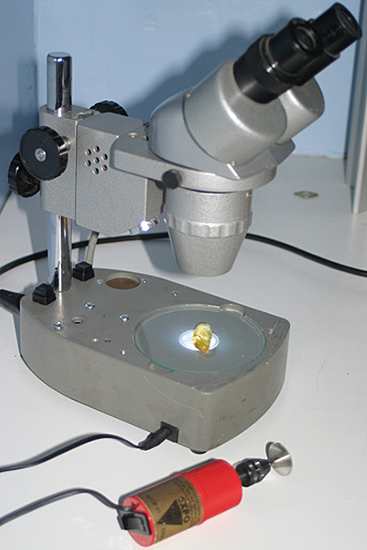 Stereomicroscope converted to LED illumination
Stereomicroscope converted to LED illumination
Many thanks to those who responded to my dilemmas regarding the benefits of LEDs. Taking some of this advice, I finally committed to removing all the wiring, sockets and switches for the original mains voltage bulbs, and based the project around a 9 LED torch head for incident illumination and a multiple LED unit, which I bought some time ago as a cheap magnetic work lamp for the car. These are generally available at less than £3.00 and run off 3 AAA batteries. Because I didn’t want to rely on battery power (they always run out at the wrong time) I wanted to fit a transformer for the LEDs and eventually bought a variable voltage adapter from Maplins. It proved remarkably easy to prise off the casing and three-pin plug and extract the transformer and circuit board, which was then mounted in a plastic project case for protection and bolted into the base of the microscope. The incident LED simply replaced the original bulb and condensing lens; the LEDs did not focus well with the lens. I also took the opportunity to mount a transformer (again removed from a mains adapter) for the miniature circular saw that I use for the initial cutting of amber, which now simply plugs into the microscope base. I suppose one final task would be to repaint the microscope. Why are microscopes always painted such dull colours? I think I might try yellow, or orange. Amazingly for me I have completed this project 24 hours before it is needed. Tomorrow the microscope is packed into hand luggage for a week’s holiday in Italy. My idea of paradise, sitting outside of the villa, working on my amber under the Tuscan sun! Interestingly, every time I take the microscope through airport security we are taken to one side and swabbed for explosives. I think the pillar of the microscope looks like a gun barrel on X-Ray – and they don’t see many microscopes going through the airport!
Best regards
Phil Greaves
May 2009
I sometimes seem to spend more time ‘messing around’ with microscopes than actually using them. I have a fairly basic stereomicroscope (a Siewa with ×10 and ×20 magnification) that I use while cutting and shaping amber. The initial shaping is done with a small circular saw that creates a lot of dust and I don’t want to spoil a better quality microscope while doing it. Whilst the stereo that I use fits the purpose well, the inbuilt mains voltage transmitted and incident lighting is often inadequate for finding a fossil insect deep in darkened amber and Carel Sartory’s superb article in the Journal on LED illumination has been uppermost in my mind for several months.
Finally, the opportunity came to obtain two multi-LED torches at the end of a recent Land Rover rally – the switches had failed but the LEDs and batteries were intact. Removing the LED board from the torch required some dramatic action with a hacksaw (an non-reversible modification so no going back now) and it has been easy to disassemble the existing built-in lighting from the microscope and temporarily position the LEDs using Blu-Tack (my answer to most engineering problems).
However, the light intensity (especially when diffused) seems no better than the original mains lamps and I am not yet convinced this will be a beneficial change. I have tried a LED ring light in the transmitted position and this is better but will cost significantly more, plus the addition of a small transformer which I was hoping to avoid.
As they say, the jury is still out. I now need to use the microscope again so I have to re-assemble everything into a working state again before deciding on the final lighting solution. It looks like I will be ‘messing around’ with microscopes for some time to come! I was interested to read that algae can dance! Researchers studying Volvox (a well-known algae consisting of up to 1,000 cells arranged in a sphere up to 0.5 mm in diameter) found that the cells form a stable grouping but ‘dance’ around each other, held together only by the fluid flows they create.
What next – singing rotifers?
Best regards
Phil Greaves
April 2009
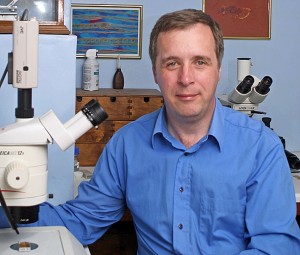 I must start with an admission; I hate the word ‘blog’! However, it is the accepted term for what is effectively a diary in cyberspace, open for all to see. It gives me the opportunity to tell you a little bit about me, what I do, and the pleasure I get from my microscopy. Unlike a real diary I will not write it nightly, but I do hope to update it at monthly intervals.
I must start with an admission; I hate the word ‘blog’! However, it is the accepted term for what is effectively a diary in cyberspace, open for all to see. It gives me the opportunity to tell you a little bit about me, what I do, and the pleasure I get from my microscopy. Unlike a real diary I will not write it nightly, but I do hope to update it at monthly intervals.
So, to start with a few words about myself. I recently described myself as having ‘one wife, two dogs (springer spaniels), three Land Rovers and too many microscopes!’ I have been a Quekett member since my late teenage years – and an enthusiastic microscopist since my early teens.
Like many of us, microscopes have come and gone as the opportunity to improve has arisen, and I am now committed to modern instruments; the quality of optics is simply superb. However, through the mentoring of Brian Davidson in particular I have developed a passion for historical instruments and slides and have slowly built up a modest collection. I am lucky in both having a dedicated room for my microscopy – and a very tolerant wife!
My main activities with the microscope are tardigrades or waterbears – the most amazing beasties – and fossilised insects in amber, about which I hope an article will soon appear in the Journal. In Quekett terms I am still quite young – 46 years old – the downside of this being that I still have to work. I started out as a practical microbiologist in the pharmaceutical industry and joined a consultancy company about 12 years ago where I am now responsible for a ‘business unit’ employing 20 consultants who help companies and government containment laboratories with meeting regulations.
Although the days can sometimes be long, the travel involved does sometimes provide the opportunity to call in on Quekett members around the country. I recently had the pleasure of a morning with Don Thomson and took with me a variety of objects I have acquired on eBay, or have been bequeathed to the Club, all in need of Don’s attention.
Amongst my purchases was a Bausch & Lomb interference objective that I had assumed to be a Mirau pattern. Don soon recognised it as a rare Tolansky design, which Don himself had not seen previously. By the time I arrived home that evening Don had telephoned with a status report on all the objects I left with him, and had already persuaded most to work properly! Thanks Don! Assuming Don and I can get the Tolansky objective to work, I’ll post some photographs on my next blog.
Best regards
Phil Greaves


